Nof S.Y. Springer Handbook of Automation
Подождите немного. Документ загружается.


Distributed Agent Software for Automation 28.3 Building Agents for the Curing System 475
quickly detected and assessed by the individual agents
that are affected by such variations. Inconsistency be-
tween observed temperatures provides the basis to
suspect, detect, and further isolate the faulty element.
Fault detection and diagnosis are key enabling fea-
tures of the agent infrastructure that drive the processes
of configuration and planning. Dynamic reconfigu-
ration may include changing the operating state of
a group of system devices in a coordinated manner as
well as dynamically changing the control for system
elements.
28.2.2 Agent Tool
The technological advantage provided by the agents
is the ability to create agent components in industrial
commercial off-the-shelf PLCs without having to cre-
ate specialized hardware and programming tools. The
advantage of using PLC devices as the primary control
and agent-hosting platform is the reliability of its op-
erating system, hardware components, and packaging,
which are readily available for industrial use.
By embedding theagents directly intothe controller,
it is possible for the agent to interoperate with the con-
trol programs faster. This embodiment eliminates the
potential loss of controllability due to a lost connec-
tion between a controlling device and the supervising
computer. Control programs ensure the hard, real-time
response required by many control applications and an
agent part ensures high-level coordination and flexibil-
ity. This synergy of agent and control inside the PLC
and in combination with smaller PLCs has made it pos-
sible to transform a physical machine into an intelligent
machine by localizing the intelligence.
The changes made to the PLC firmware include
software extensions to the tasking model of the con-
troller, object instantiation and retention during power
cycles, and a more general communication layer. Great
effort took place initially to make the PLC an agent-
hosting device with the capability to absorb executable
agent code via object downloading. The extensions to
the communication layer covered the generation and
parsing of FIPA-based messages. With this feature, the
control-based agents talk to other agents that comply
with the FIPA specifications, even those that may have
been implemented using a different infrastructure.
To make the agent system scalable and manage-
able in terms of software for agent development, it was
necessary to create a development environment for the
programming of agent libraries [28.35]. There are five
main phases of agent development:
1. Template library design
2. Facility editor
3. Control system editor
4. Assignment wizard
5. Control code generator.
In the template library editor, a collectionof compo-
nents to represent the physical system is identified and
built with control and reasoning parts. These compo-
nents are generic, without referring to specific instances
or devices. The library of components is then instan-
tiated and arranged in a specific tree to represent the
hierarchical order and attributes of the components that
will be part of a specific system. This is where pa-
rameters of controlled devices and locations are added.
The control system editor helps in the selection of the
control and communication network equipment. In ad-
dition, it helps in the assignment of the input and output
(I/O) points.
Once the pieces above are defined, the control and
reasoning components defined within theapplication (in
the facility editor) are assigned to specific controllers
(PLCs). After the assignment, the executable code is
generated and downloaded to the controllers.
28.3 Building Agents for the Curing System
The purpose of modeling the composite process us-
ing industrial agents is to increase the degree of
survivability, diagnostics, and reconfigurability of the
system [28.36]. Survivability of the control system is
very important since it is directly related to safety and
the creation of scrap material.
Curing is a long process and therefore there is
a greater time span during which disruption may oc-
cur. Situations such as power shutdowns and network
discontinuity are of critical importance and these must
be handled in a timely way to sustain high process in-
tegrity. Since the curing process consists of applying
heat and cooling to composite material inside a sealed
autoclave, a reliable system to operate on top of the
temperature sensors is fundamental. The thermocouples
read the temperature of the composite material at differ-
Part C 28.3
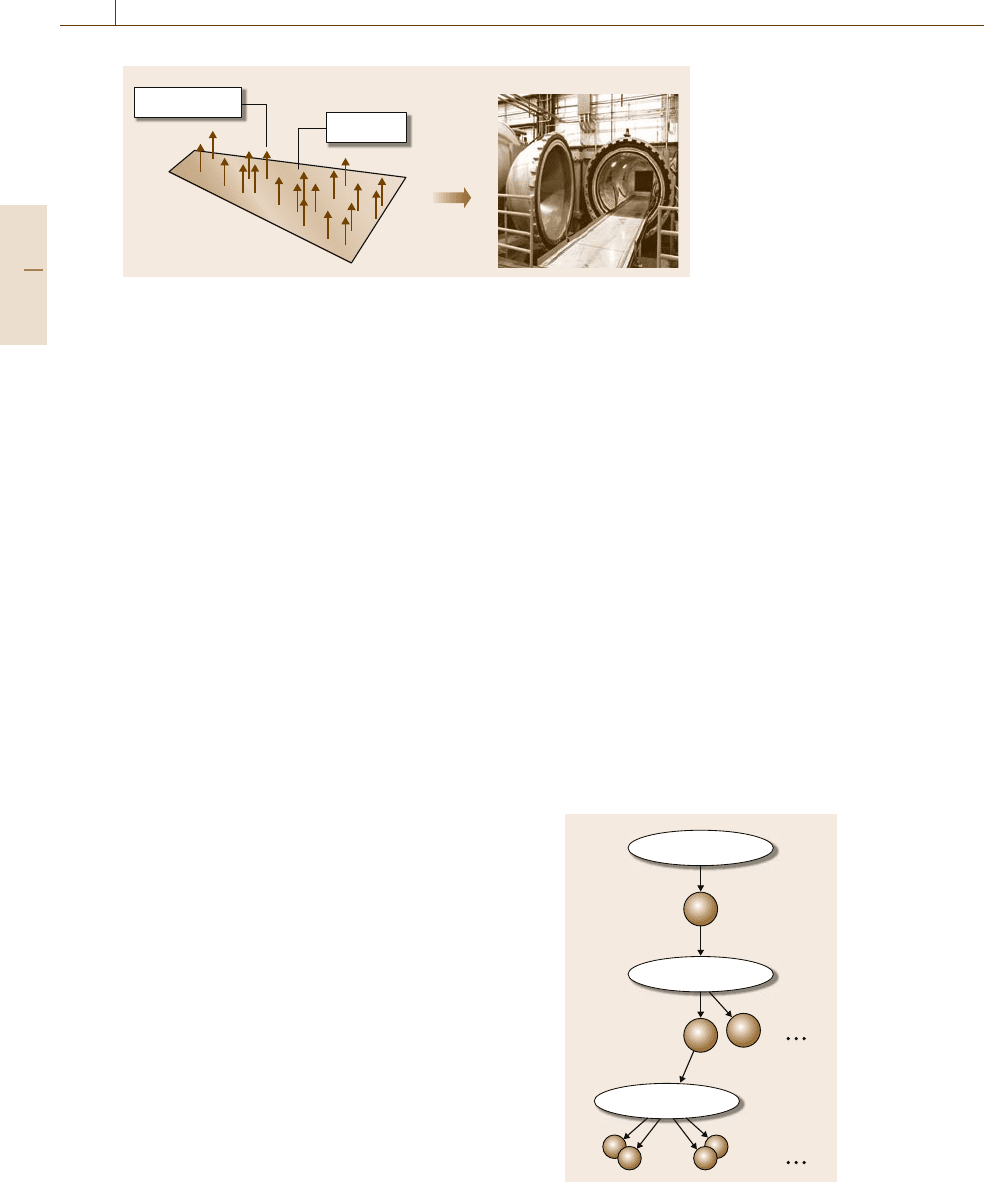
476 Part C Automation Design: Theory, Elements, and Methods
Composite
Thermocouple
Autoclave
Fig. 28.3 Composite curing
ent locations. Moreover, since these constitute a group
of logically interconnected sensors, the thermocouples
are treated as a multisensor problem. Figure 28.3 il-
lustrates how a composite material part is populated
with the multisensor array prior to its placement in-
side the autoclave furnace. Thermocouple agents will
be created to represent the thermocouple devices in the
controller. The agents will use their social skills to or-
ganize the array into a smart and highly reconfigurable
logical structure.
Given that the process operates in a controlled vac-
uum, it is not possible to stop the process to adjust
a loose thermocouple, for example. Therefore, the au-
todiagnosability of the process is a critical factor that is
made a part of the decision-making roles of the agents.
As a consequence, both the supervisory and control
roles must be able to detect problems and reconfigure
the physical system to cope with such eventualities in
order to enable continuous, uninterrupted activity.
Factorssuch asnonlinearities of the process and ma-
terial (exothermal reactions provoking thermal spikes)
must be considered in the modeling of the supervisory
intelligence. The agent technology discussed herein
allows for an incremental implementation of the neces-
sary rules. The agent’s decision power resides in rules,
which are encapsulated in the behaviors. A validation
framework based on simulation helps to create a virtual
model for testing and enhancing the curing control rules
and loops of the agents and control algorithms.
The agent software that is downloaded to the PLC is
associated with a control-level driver (IEC-61131 con-
trol programs). The agent directs the control system
using a lightweight supervisory strategy. Agents do not
perform direct control. The device drivers carry out di-
rect controlupon theequipment. Thus,to avoiddecision
collisions and misinterpretation of the world, the sphere
of influence of each agent must be defined with respect
to its associated physical device.
The distribution of the agents throughout specific
sections of the application is a necessary partitioning of
responsibility that needs to take place before program-
ming the rules. In the current case, the application is
made ofa singlemachine (autoclave)with amultisensor
array (thermocouples).
There are three partitioning criteria to model the
system:
1. One-to-one
2. One-to-many
3. Many-to-one.
One-to-one portioning exists in physical devices
that can be isolated and classified as independent work
units. Typical examples of such a case are a valve,
switch, or breaker. In this case, one agent per physi-
cal device is enough. A one-to-many case appears in
complex systems, where there is still an easy classifica-
tion of the work units. This type of partitioning happens
in equipment grouping situations, whereby one agent
can be associated with a group of related physical de-
vices. A rarer case is many-to-one partitioning,in which
multiple agents are associated with a single or grouped
Curing system
Autoclave
Thermocouples
Fig. 28.4 Agent
classification for
curing system
Part C 28.3
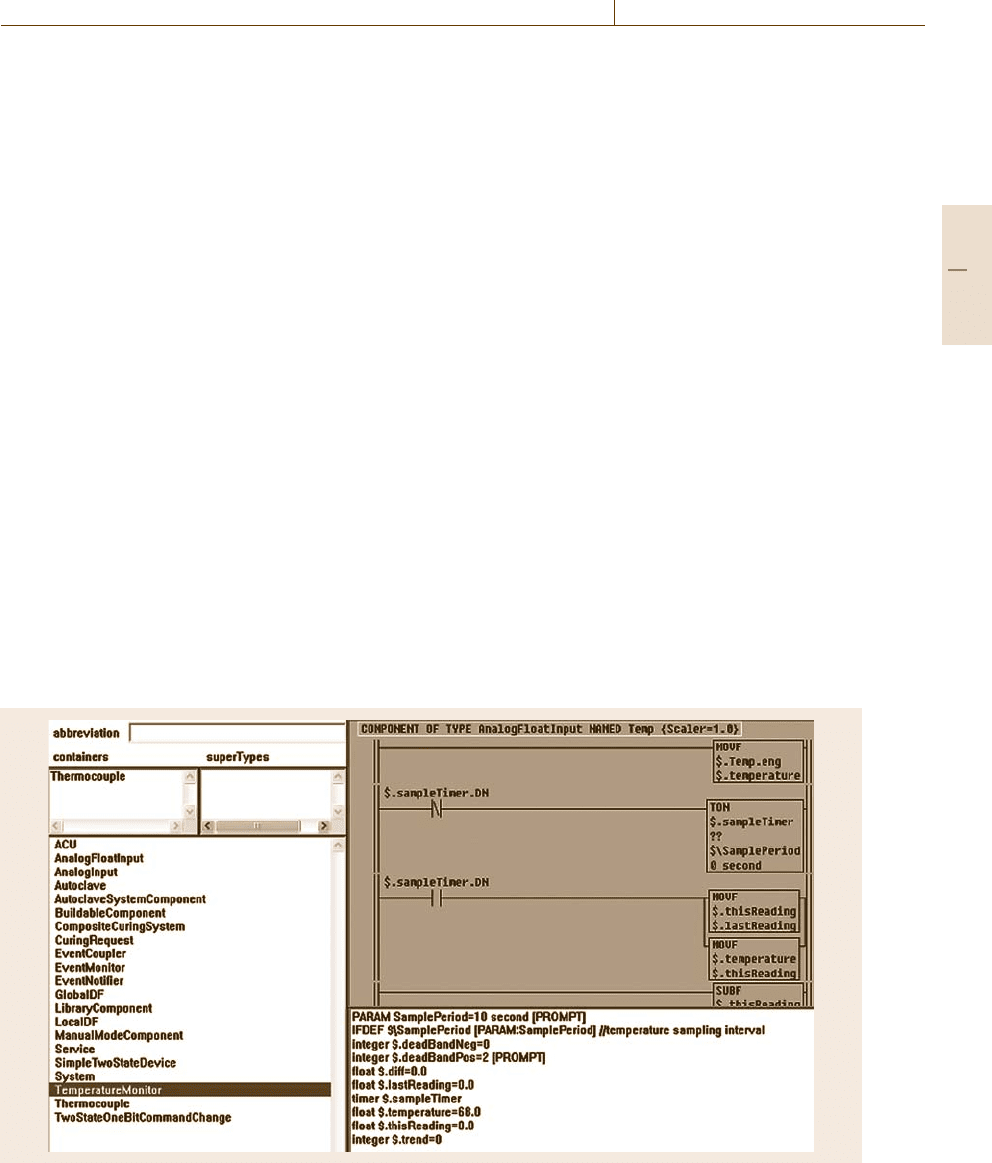
Distributed Agent Software for Automation 28.4 Autoclave and Thermocouple Agents 477
physical device. A typical situation of this type oc-
curs when a single agent cannot cope with too many
concurrent processes.Efficiency of the decision-making
process is then measured in terms of communication
latencies and decision-making convergence. A system
with too many agents and processes has many more
messages on the network. The network may become
overwhelmed with too many packets and communica-
tion latencies may increase. Since agents collaborate
with their peers through the exchange of information,
they heavily depend on timely arrival of information
during the group decision process. Thus, it may occur
that the agents begin dropping out of the conversation
without concluding a decision process. In this case,
agents would retry communication, causing more mes-
sages and therefore problems in convergence. Thus,
special care must be taken to obtain a good partitioning
of agent functionality.
The composite curing system corresponds to
a three-tier one-to-one system. As shown in Fig.28.4,
the top-level tier has one agent to represent the overall
curing system. The second tier represents the autoclave
machinery that will be part of the curing system. There
is one autoclave agent per autoclave machine. The third
tier represents the thermocouple sensor level. There is
one agent per thermocouple.
28.4 Autoclave and Thermocouple Agents
A bottom-up design (from the simplest part of opera-
tion to the more complex behavior) of the components
takes place to build the curing system. Each component
is associated with a piece of equipment or a partic-
ular process as an agent. Figure 28.5 shows a group
of curing components. Most of the components are
control-oriented drivers. However, autoclave and ther-
mocouple components are agents.
The left-handside ofFig.28.5 shows the component
list. The upper-right part shows the low-level program-
ming blocks of the component. The lower-right part
Fig. 28.5 Component list
shows the list of control parameters of the component,
such as input and output (I/O) variables.
28.4.1 Autoclave Agent
The autoclave agent contains curing artifacts such as
cooler, heater, pressure compressor, and thermocouples.
Thermocouple agents have their own temperature mon-
itoring system and personality. Depending on the stage
of the curing process, an autoclave agent periodically
requests a reorganization of the thermocouples to se-
Part C 28.4
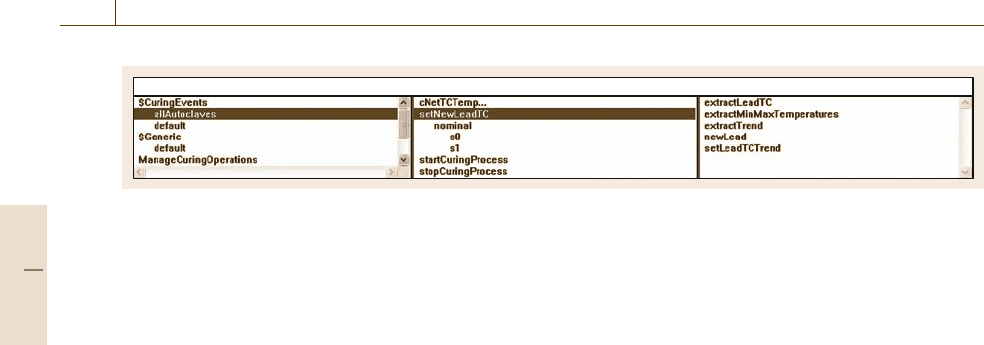
478 Part C Automation Design: Theory, Elements, and Methods
Template behaviorAgent capability Procedures
Fig. 28.6 Agent capabilities, behaviors, and procedures
lect a leading and a lagging thermocouple. The nominal
behaviors given to an autoclave agent consist of the
following:
•
cNetTCTemp: This behavior generates a multicast
message to all dependent thermocouples (TC1–
TC16 in Fig. 28.2 to have them summarize their cur-
rent temperature trends. Asynchronous responses
are sent by the thermocouple agents to report their
temperature information.
•
SetNewLeaTC: In this behavior, the autoclave agent
applies process-specific criteria to generate a list of
leading and lagging thermocouples. The autoclave
agent uses a min–max selection mechanism. The
process recipe and the stage of curing determine the
temperature boundaries (upper and lower).
•
startCuringProcess: This behavior contains the
startup sequence of the autoclave.
•
stopCuringProcess:This behavior contains theshut-
down sequence of the autoclave.
The aggregation of capabilities into the agent behavior
creates the rules of the agent incrementally. In Fig.28.6
all autoclave agents have the CuringEvent capability,
which implements a set of template behaviors. Each
behavior is associated with a set of procedures.
28.4.2 Thermocouple Agent
A thermocouple agent has two essential behaviors to
monitor the temperature of the process and the sensor
condition and trending using the following behaviors
•
getTemperature: This behavior uses a sampling
algorithm to calculatetemperature average and stan-
dard deviations.This behavior allowsfor continuous
adjustment of temperature measurement to compen-
sate for natural jitter.
•
provideTemperatureTrend: This behavior enables
the detection of temperature variations outside the
nominal ranges. The feasible range allows for
the detection of extreme deviations from nominal
trends. These events are reported to the autoclave
agent as events.
Each thermocouple carries out continuous sam-
pling of the temperature. This information is processed
statistically. Temperature sampling is an internal-to-
thermocouple action, which corresponds to an intera-
gent communication. The thermocouple agents receive
requests from the autoclave agent to transmit their
temperature trends in the form of agent messages in
a periodic fashion.
28.5 Agent-Based Simulation
Simulation is made up of two parts: the machine and the
material. Machine simulation covers the autoclave ma-
chine itself with its mechanical devices (such as heater,
cooler, and compressor) and thermocouples. Material
simulation mimics the behavior of the composite ma-
terial. A finite-difference mesh simulates the thermal
dissipation throughout the material. The model repre-
sents a single piece of composite material of square
shape with arbitrary sides and thickness.
The control process takes place in a PLC.How-
ever, for the purpose of the simulation, a soft controller
PLC (Rockwell Automation, SoftLogix 5800) with
firmware extensions to support the agents was used.
The Simulink/Matlab engine was used as the simula-
tion toolset.To mimic the physical process,a simulation
of the material, thermocouples, and material was cre-
ated. Theagents usethe simulationas the process model
instead of the actual machine and material.
In Fig. 28.7 there are horizontally and vertically ar-
ranged gray rectangular boxes. These boxes contain
heat transfer differential equations to calculate the ac-
cumulation and dissipation of heat on a specific node
of the finite-difference mesh. The heat transfer model
is subjected to anisotropic properties to mimic the heat
Part C 28.5
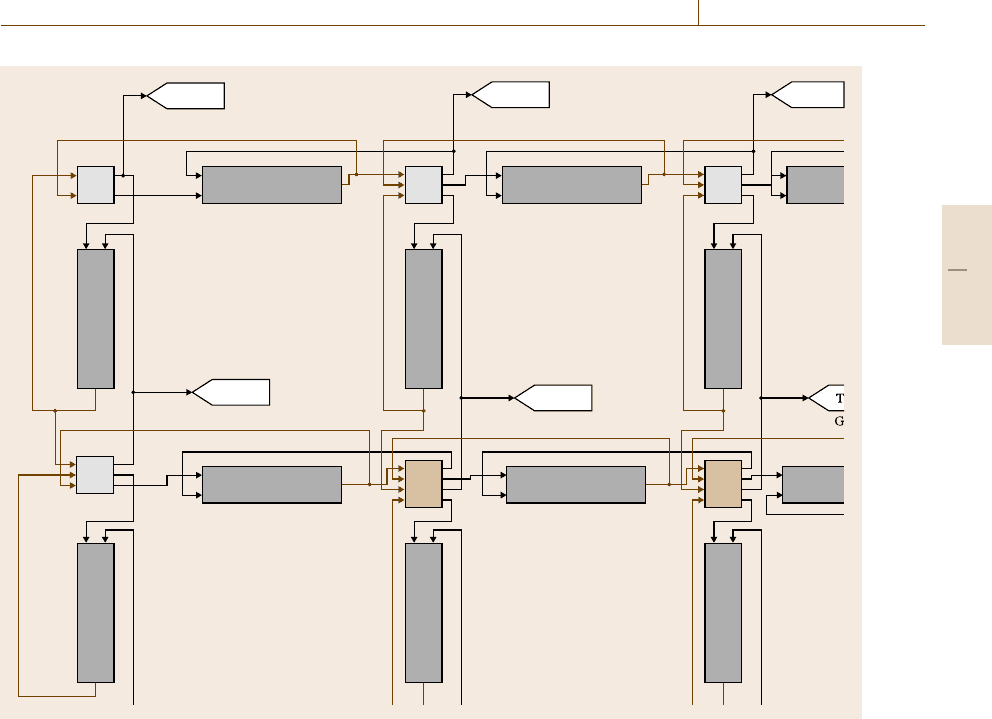
Distributed Agent Software for Automation 28.5 Agent-Based Simulation 479
TC01
Goto
TC05
Goto4
TC06
Goto5
TC02
Goto1
TC03
Goto2
A0
B0
T1
T2
T
out
T1
T2
T
out
T1
T2
T1
T2
T
out
T
out
A1
B1
A0
B0
C0
A1
B1
C1
A0
B0
C0
D0
A1
B1
C1
D1
A0
B0
C0
A1
B1
C1
T1 T2
T
out
T1 T2
A0
B0
C0
A1
B1
C1
T
out
T1 T2
T
out
T1 T2
T
out
T
out
T1 T2
T1
T2
T
out
T1
T2
A0
B0
C0
D0
A1
B1
C1
D1
T1 T2
Fig. 28.7 Composite material simulation
dissipation rates throughout the material. The chemical
composition of the resin affects the heat transfer, mak-
ing it vary with location and direction of propagation.
The square boxes represent finite-difference nodes
(concentration nodes) to calculate the average tem-
perature of the material at the specific location of
measurement. Figure 28.7 shows just a small section
of the finite-difference mesh. In the actual model, there
are 16 concentration points and 16 thermocouples. The
thermocouple sensors are scattered throughout the ma-
terial to measure the temperature of the composite at
each node. The temperature readings are sent to the
PLC as an input array of temperatures to be further
interpreted by the thermocouple control drivers.
Figure 28.8 shows the simulation blocks that
contain the autoclave and autoclave’s inner atmo-
sphere. The autoclave agent connects to the simu-
lation throughout six inputs parameters (heaterIsOn,
coolerIsOn, coolerIsEnabled, heaterIsEnabled, heatin-
gRate, coolingRate) to control the autoclave. The
maximum and minimum heating and cooling rates are
provided in the curing recipe. Heating and cooling rates
are used as the control variables to control the amount
of heat that is applied to the material. Table 28.1 shows
an example of the command that initiates a heating-up
phase in the simulation.
Control commands drive the simulation in desired
directions to achieve a particular curing profile. All 16
thermocouple readings must be maintained within the
curing envelope (refer to Fig. 28.1 for the profile shape).
Deviations from the curing envelop are regulated by
the cooperative actions of the agents. The agents contin-
uously monitor the health of the thermocouples using
temperature trending and standard deviations. When
a thermocouple fails, the agent that represents that ther-
mocouple decides to dismiss itself from the monitoring
array. This decision is taken autonomously at the lowest
level. The dismissal cascades up the hierarchy, inducing
Part C 28.5
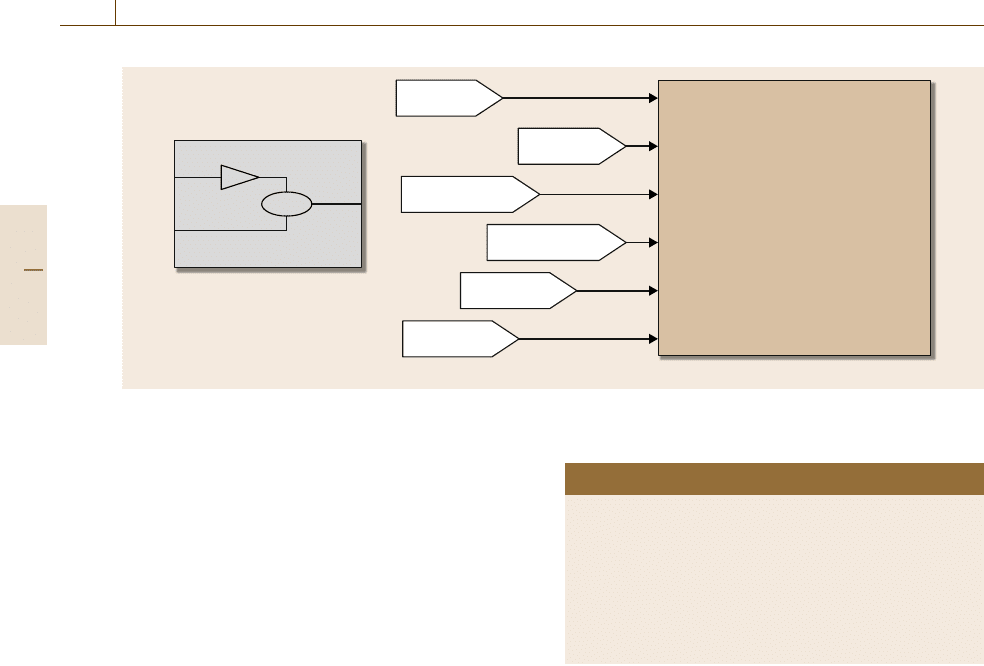
480 Part C Automation Design: Theory, Elements, and Methods
Autoclave atmosphere
Heating/cooling unit
(heaterIsOn)
(coolerIsOn)
(coolerIsEnabled)
(heaterIsEnabled)
(heatingRate)
(coolingRate)
Fail heater = 0
Fail cooler = 0
heaterIsOn
coolerIsOn
coolerIsEnabled
heaterIsEnabled
heatingRate
coolingRate
Fig. 28.8 Autoclave and autoclave atmosphere simulation
a reorganization of the sensor array to adjust to the new
reading set.
If a departing thermocouple was operating as a lead-
ing or lagging thermocouple, the current stage of curing
is at high risk since the autoclave agent loses its win-
dow into the process variable. The reorganization of
the sensor arrays implies a discovery of new leading
and/or lagging thermocouples to reestablish the process
variable. While the agents reorganize the system, the
control must continue its normal activity by maintaining
all temperatures withinthe nominal rangesas prescribed
in the recipe, but this fall-back position can only be sus-
tained for a short period until the new process variable
is reestablished. This reorganization activity is the core
Table 28.1 Autoclave heat-up command
Variable name Value
heaterIsEnabled true
coolerIsEnabled false
coolerIsOn false
heaterIsOn true
heatingRate %.%
coolingRate %.%
benefit of the multiagent system. Agents are intended to
handle these dynamic decisions.
28.6 Composite Curing Results and Recommendations
The composite curing process begins with download-
ing of the agents and device drivers into the PLC.Next,
the process simulation is started and connected to the
soft controller throughout and automation proxy. The
role of the automation proxy is to exchange I/O data be-
tween the controller and the simulation, as well as the
synchronization of their clocks.
There are several aspects of interest that can be ex-
tracted from this technology. First, there is a permanent
learning process associated with the encapsulation of
the behaviors into particular agents, as well as the parti-
tioning of the domain into regions.
28.6.1 Designing the Validation System
The system designer carries out preliminary verifica-
tions to test the agent behaviors. It is natural to see
some chaotic results in the initial iterations. The de-
signer adjusts the agent and control functions to make
the prototype stable and observable using an interactive
process.
The design of the agent is based on tem-
plates [28.35]; for instance, only one thermocouple
agent template is built for all 16 thermocouples.
Likewise, in object-oriented programming, agent pro-
Part C 28.6
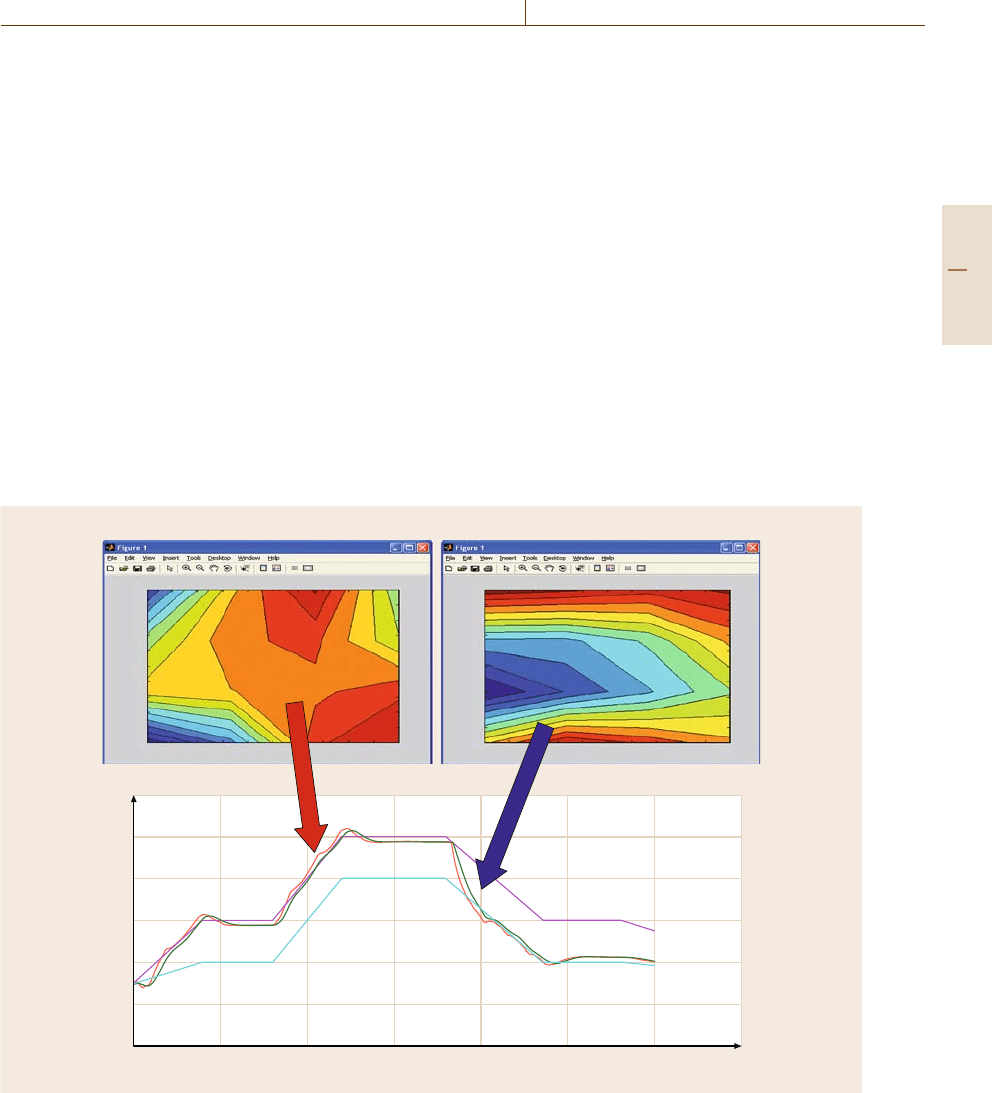
Distributed Agent Software for Automation 28.6 Composite Curing Results and Recommendations 481
gramming allows for the creation of agent instances
from a single agent template. Thus, all thermocouple
agents share the same reasoning rules but vary in per-
sonality (name, location, ranges, etc.).
Another consideration is the speed of the simula-
tion. The real curing process takes hours to complete.
However, during the modeling and validation phase
it is not affordable to spend so much time waiting
for events and changes in the process, so the sim-
ulation has to be accelerated to compress the total
time. This requirement adds complexity to the model
since the controller cycles must be in real time to
mimic actual control. Time compression is factored
into the control timers to make events observable in
shorter time spans. In this curing model, ideal time
spans during the validation phase d should not exceed
30min/cycle. Once the overall model is ready, tests
begin to check the control/agent responses against the
system dynamics.
0 1000 2000 3000 4000 5000 6000 7000
Temperature
Time
Agent curing control–enhanced rules
Heating Cooling
300
250
200
150
100
50
0
100
90
80
70
60
50
40
30
20
10
0
0 102030405060708090100
100
90
80
70
60
50
40
30
20
10
0
0 102030405060708090100
Fig. 28.9 Heating and cooling simulation
28.6.2 Modeling Process Dynamics
A critical requirement in agent-based engineering is
the interdisciplinary attitude of the engineers. The cre-
ation of these sophisticated models requires more than
one design perspective to create valid results. The
designer transits from sole software engineer into a con-
trol engineer who understands the dynamics of the
process.
Figure 28.9 shows the distribution of temperature
for one of the test runs. The colored regions represent
isothermals for heating and cooling. The isothermals
change in shape and size as the curing process evolves.
The curing profile is shown in the lower half of
Fig.28.9. The temperature distribution is not uniform
due to the properties of the material. The thermal reac-
tion of the composite makes hot and cold spots change
location and size over time. The control system must
maintain all temperatures within the upper and lower
Part C 28.6
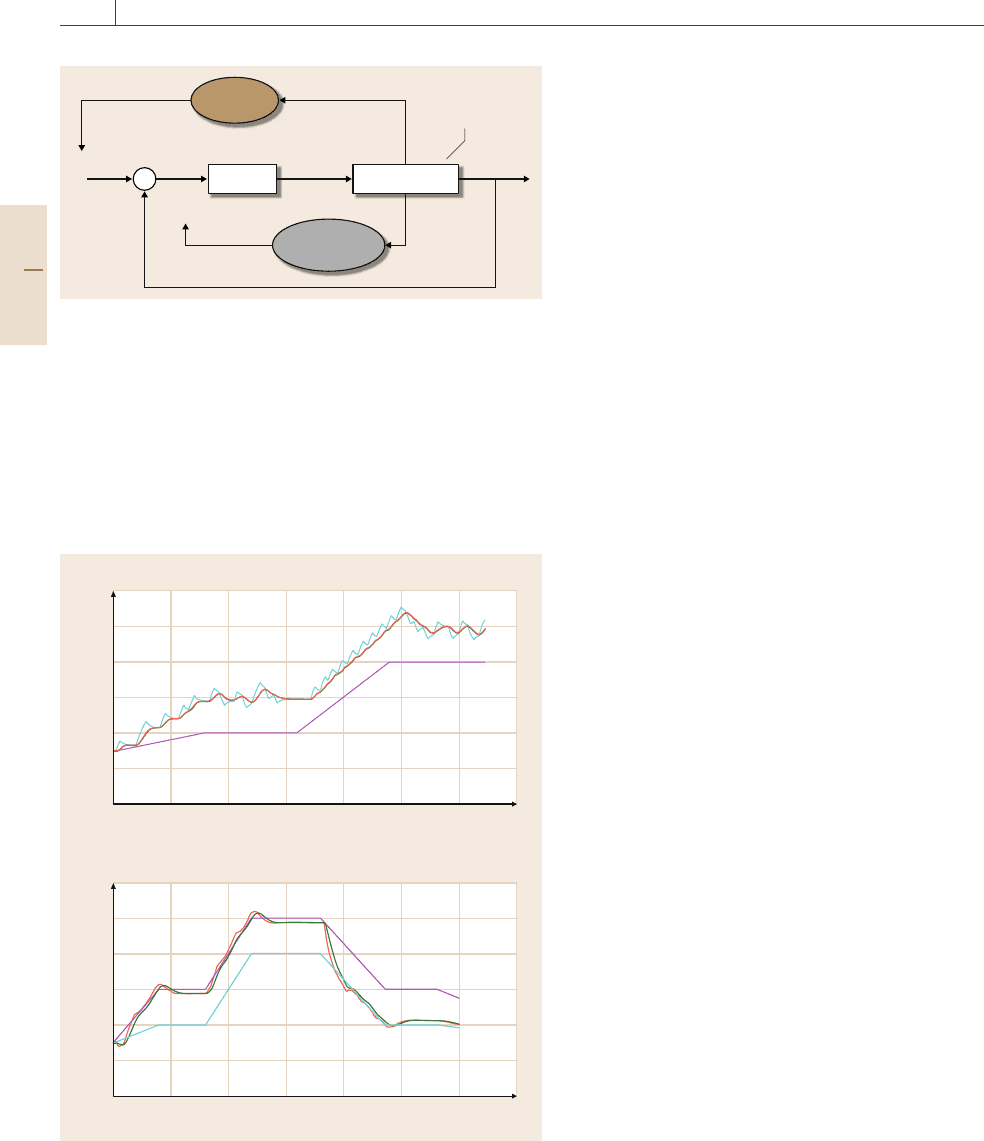
482 Part C Automation Design: Theory, Elements, and Methods
Curing model
Perturbations
PID
Autoclave
agent
Thermocouple
agents
T
representative
T
set
Fig. 28.10 Agents and control cooperation
bound of the curing envelope. The profile introduces
abrupt changes in the temperature slopes when mov-
ing from a neutral stage into a heating or cooling stage.
The control system must regulate the overshooting am-
plitude while maintaining a good configuration of the
thermocouple. There is overshooting in the process but
the recipe allows for some operation outside the bound-
aries for short periods.
0 500 1000 1500 2000 2500 3000 3500
a) Temperature (°C)
Time (min)
Agent curing control-simple rules
300
250
200
150
100
50
0
0 1000 2000 3000 4000 5000 6000 7000
b) Temperature (°C)
Time (min)
Agent curing control–enhanced rules
300
250
200
150
100
50
0
Fig. 28.11 (a) Control response for large look-ahead factor. (b) Con-
trol response for small look-ahead factor
The core activity is to observe and diagnose the
thermocouple readings to select the representative
temperature of the process as the process variable.
Cooperation among the thermocouples helps in de-
termining this information autonomously. It is very
important that the agents maintain close inspection of
the temperature sensors and ensure correct selection of
the representative temperatures to be able to set the
heating and cooling rates, as the material is very sus-
ceptible to these rates.
The control system has been implemented as a com-
bination of a proportional–integral–derivative (PID)
block with agents, as shown in Fig.28.10. The com-
bined operations of PID and agents constitute the main
control loop to generate heating and cooling rates as
the control response. The agents interact with the PID
in two main ways. First, to execute an accurate con-
trol response, the agents select the lead temperature
for the particular stage of the process, which could be
heating, cooling or neutral. The autoclave agent calcu-
lates the temperature set-point (T
set
) as an input to the
PID block. The temperature set-point is calculated to
be in the proximity of the upper or lower bound of the
profile depending on the stage of curing. Second, the
thermocouple agents collect data from the curing model
(simulation) to select T
representative
. The PID block en-
sures that the process variable is driven closer to the
set-point value.
The PID block requires empirical calibration to
adjust the proportional, integral, and derivative coeffi-
cients of the equation. The tuning is performed online
while running the simulation and controller (for more
information on how totune PID coefficients please refer
to the control system designliterature). The shape of the
curing profile introduces too drastic inflections, making
it harder to maintain the steady-state condition. Nev-
ertheless, the introduction of the agents into the loop
allows for quicker and better utilization of the system
variables to cope with such changes.
The ability to look ahead into the future (greater
than 60s) was introduced into the agents to learn future
inflections in the curing profile. The intention was to ad-
just the set-point to begin compensation early to prevent
overshoot. However, it was learned that the resultant
control response constrained the PID action by pro-
voking oscillation, as shown in Fig.28.11a. Throughout
experimentation, it was learned that the extent of the
look-ahead factor played a critical role in the instabil-
ity observations. The look-ahead factor was reduced
to a less than 30s horizon to make the PID filtering
more dominant in the control of the overshooting, as
Part C 28.6
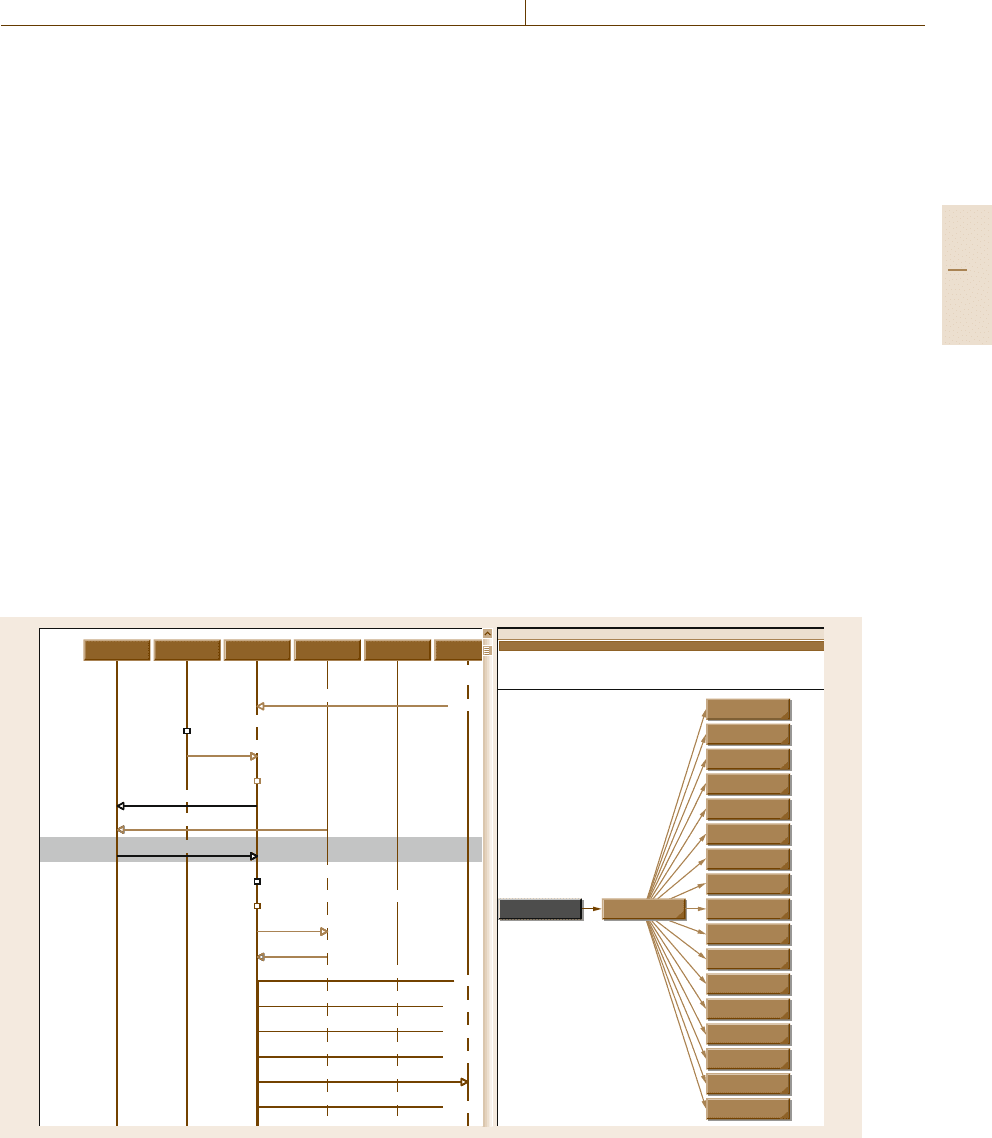
Distributed Agent Software for Automation 28.6 Composite Curing Results and Recommendations 483
showninFig.28.11b. Nonetheless, the inflexion points
are still a difficult aspect to handle using the discussed
agent control algorithm. Without agent support, the
inflexion points that are introduced by the curing pro-
file will be confined to a PID loop fine-tuning task.
By expanding and contracting the look-ahead factor
of the agents, it is possible to perceive the effect of
the agent reasoning on the PID loop response. Ideally,
agents will act rapidly with a very short look-ahead
factor to provide better input to the PID loop. How-
ever, agents are not intended to carry out control;
they are designed to influence the control algorithm
in a beneficial direction. An important lesson from
this experiment is the notion of role separation: that
which belongs to control must be in the control layer.
How to define this boundary is still an art rather than
a science.
Figure 28.11b shows an improved response, where
the temperature profile follows the recipe with no oscil-
lations. According to specifications, the resultant cured
material from this experimental trial would be consid-
ered of high quality. To obtain an optimum solution
further adjustmentsto the PID coefficients and agent ac-
tions are required and perhaps an expansion of the agent
TC02
(221)
2008-03-17 15:26:07
InformExecute(Success)
Actual CMs = 0
InformExecute(Success)
RequestRecruitAll
RequestPlan(ManageCuringOperations.on)
InformRecruitAll
RequestHandleEvent
InformHandleEvent
InformRecruitAll
InformExecute(Success)
Actual CMs = 0
RequestPlan($CuringEvents.startCuringProcess)
Actual CMs = 0
to TC08 from TC08
(222)
2008-03-17 15:26:07
(223)
2008-03-17 15:26:07
(224)
2008-03-17 15:26:07
(225)
2008-03-17 15:26:07
(226)
2008-03-17 15:26:07
(227)
2008-03-17 15:26:11
(228)
2008-03-17 15:26:11
(229)
2008-03-17 15:26:11
(230)
2008-03-17 15:26:12
(231)
2008-03-17 15:26:12
(232)
2008-03-17 15:26:12
(233)
2008-03-17 15:26:12
ACSObj1 Autoclave01 Curing GlobalDF1 TC01
from TC08
to TC12
RequestPlan(ManageCuringOperations.on)
RequestPlan(ManageCuringOperations.on)
to TC05
RequestPlan(ManageCuringOperations.on)
RequestPlan(ManageCuringOperations.on)
to TC06
RequestPlan(ManageCuringOperations.on)
to TC16
RequestPlan(ManageCuringOperations.on)
to TC09
$CuringEvents.start...
Curing
$CuringEvents.start...
ACSObj1
ManegeCuringOpera...
TC12
ManegeCuringOpera...
TC09
ManegeCuringOpera...
TC16
ManegeCuringOpera...
TC06
ManegeCuringOpera...
TC02
ManegeCuringOpera...
TC05
ManegeCuringOpera...
TC04
ManegeCuringOpera...
TC13
ManegeCuringOpera...
TC11
ManegeCuringOpera...
TC15
ManegeCuringOpera...
Autoclave01
ManegeCuringOpera...
TC01
ManegeCuringOpera...
TC07
ManegeCuringOpera...
TC14
ManegeCuringOpera...
TC03
ManegeCuringOpera...
TC10
ManegeCuringOpera...
TC08
Details
RequestHandleEvent
InformHandleEvent
Fig. 28.12 Agent communication
intelligence. Nevertheless, these improvements fall out-
side the scope of this chapter.
During the agent cooperation, the agents talk to
each other using the FIPA/JDL messaging protocol.
Figure 28.12 shows an example agent communication.
The observer can trace the agent transactions to learn
what decisions have been made. The transactions show
the information that the agents exchanged to arrive at
a control decision. In Fig.28.12 a multicasting exam-
ple is shown, where a single agent contacts multiple
agents in a two-way transaction. In multiagent systems,
interagent communication consists of request/inform
transactions, where an agent transmits a request for in-
formation to one or a group of agents. The receiving
agents process the request locally but may initiate con-
sultation with other agents as well by using similar
request/inform transactions. Once the receiving agent
has finished preparing its response, it uses an inform
message to send the information back to the requester.
The requester then receives multiple responses from the
agents. Each response provides a different perspective
of the situation under consultation. The requester must
select the most valuable information or a combination
of it to conclude its own decision-making cycle.
Part C 28.6

484 Part C Automation Design: Theory, Elements, and Methods
The distributed nature of agent messaging allows
for a realistic expansion of the system to add/remove
functionality as desired.
In the current implementation, all agents reside
within one controller, but the agents can be distributed
in any desired topology. The distribution topology is
a design decision that must comply with the applica-
tion’s characteristics and requirements. A rule of thumb
to decide on the agent distribution is to weigh the
desired degree of survivability, diagnosability, and re-
configurability of the system.
In a distributed agent implementation, agents reside
in separate platforms. The distribution of the agents
depends on the partitioning criteria selected for the
application. The partitioning criteria takes under con-
siderations the number of messages used in negotiation.
The idea is to use a reduced number of messages.
A poor division of functionality among the agents will
result in more messaging among them. Message traf-
fic and bandwidth utilization are good metrics to define
optimum partitioning.
28.6.3 Timing and Stability Criteria
The multiagent system guarantees an exhaust search for
an optimum configuration within a specific time hori-
zon. For small systems(< 100agents), it isfairlysimply
to establish the time horizon required by the agents to
accomplish a complete search of configurations. The
time horizon estimation is established by injecting var-
ious conditions into the simulation model so the system
designer can observe what time is required to search
for and converge to a solution. Once this time hori-
zon is estimated, each agent is given a factored time
limit to participate in a particular negotiation process.
An infinite time horizon is never given to the agents
to avoid deadlocks. Unknown singularities could gen-
erate deadlocks in the system. It is guaranteed that the
agents will find a solution within the predefined time
horizon. However, the value of the solution will fluc-
tuate within optimum and-near optimum performances,
depending on the complexity of the emergent search
space.
28.7 Conclusions
This chapter has shown how to use industrial agent
technology to solve a composite curing application.
It has also shown some of the technology require-
ments and implications of extending industrial PLCs
with agent firmware. An example application was
used to show the design and modeling phases and
the validation of the solution using simulation. Im-
portant results and recommendations can be extracted
from this to help the modernization of curing tech-
nology. Using interagent messaging and the ability to
cooperate on the creation and assessment of thermo-
couple configurations, the agents enable a dynamic
learning system, always adapting to current condi-
tions.
The PLC firmware provides for a multitasking
priority-based executive control cycle. Agents on built
as user level tasks to execute at a low priority. Funda-
mental tasks in the PLC that manage the PLC’s integrity
are never interrupted by the agent tasks. User-defined
tasks such as stand-alone periodic and continuous con-
trol loops compete with agent tasks, but based on their
priority levels. Among these, periodic tasks are higher
order than agents, but never higher than the executive
functions.
The extent of learning depends on the sophistica-
tion of the rules given to the agents. This aspect is
a user-defined characteristic of the system. Agent pro-
gramming provides for this type of flexibility. It has
been learned that loosely coupled agents and control
components ease the scalability of the control solution.
Finally, this chapter has shown how survivability, diag-
nostics, and reconfiguration of a control system can be
achieved with component-level intelligence in a more
compact manner.
28.8 Further Reading
1. F. Bergenti, M.P. Gleizes, F. Zambonelli (Eds.):
Methodologies and Software Engineering for Agent
Systems: The Agent-Oriented Software Engineering
Handbook (Springer, New York 2004)
Part C 28.8
